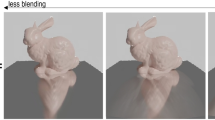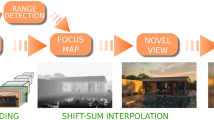Abstract
Light field rendering and displays are emerging technologies that produce more immersive visual 3D experiences than the conventional stereoscopic 3D technologies, as well as provide a more comfortable virtual or augmented reality (VR/AR) experience by mitigating the vergence–accommodation conflict. Path tracing photorealistic synthetic light fields in real time is extremely challenging, since it involves rendering a large amount of viewpoints for each frame. However, these viewpoints are often spatially very close to each other, especially in light field AR glasses or other near-eye light field displays. In this paper, we propose a practical real-time light field path tracing pipeline and demonstrate it by rendering a \(6\times 6\) grid of 720p viewpoints at 18 frames per second on a single GPU, through utilizing denoising filters and spatiotemporal sample reprojection. In addition, we discuss how the pipeline can be scaled to yield higher-quality results if more parallel computing resources are available. We also show that our approach can be used to simultaneously serve multiple clients with varying light field grid sizes, with the quality remaining constant across clients.
Access this chapter
Tax calculation will be finalised at checkout
Purchases are for personal use only
Similar content being viewed by others
References
Andersson, M., Johnsson, B., Munkberg, J., Clarberg, P., Hasselgren, J., Akenine-Möller, T.: Efficient multi-view ray tracing using edge detection and shader reuse. Vis. Comput. 27(6–8), 665–676 (2011)
Flynn, J., Neulander, I., Philbin, J., Snavely, N.: Deepstereo: learning to predict new views from the world’s imagery. In: Proceedings of IEEE Conference on Computer Vision and Pattern Recognition (2016)
Fraboni, B., Iehl, J.C., Nivoliers, V., Bouchard, G.: Adaptive multi-view path tracing. In: Proceedings of 30th Eurographics Symposium on Rendering (2019)
Hansen, A.J., Klein, J., Kraus, M.: Light field rendering for head mounted displays using pixel reprojection. In: VISIGRAPP (1: GRAPP) (2017)
Hedman, P., Philip, J., Price, T., Frahm, J.M., Drettakis, G., Brostow, G.: Deep blending for free-viewpoint image-based rendering. ACM Trans. Graph. 37(6), 1–15 (2018)
Hoffman, D.M., Girshick, A.R., Akeley, K., Banks, M.S.: Vergence-accommodation conflicts hinder visual performance and cause visual fatigue. J. Vis. 8(3), 33 (2008)
Hua, H.: Enabling focus cues in head-mounted displays. Proc. IEEE 105(5), 805–824 (2017)
Huang, F.C., Luebke, D., Wetzstein, G.: The light field stereoscope. In: ACM SIGGRAPH 2015 Emerging Technologies. ACM, New York (2015)
Huo, Y., Yoon, S.E.: A survey on deep learning-based Monte Carlo denoising. Comput. Vis. Media 7(2), 169–185 (2021)
Işik, M., Mullia, K., Fisher, M., Eisenmann, J., Gharbi, M.: Interactive Monte Carlo denoising using affinity of neural features. ACM Trans. Graph. 40(4), 1–13 (2021)
Koskela, M., et al.: Blockwise multi-order feature regression for real-time path-tracing reconstruction. ACM Trans. Graph. 38(5), 1–14 (2019)
Lanman, D., Luebke, D.: Near-eye light field displays. ACM Trans. Graph. 32(6), 1–10 (2013)
Lehtinen, J., Aila, T., Chen, J., Laine, S., Durand, F.: Temporal light field reconstruction for rendering distribution effects. In: ACM SIGGRAPH 2011 Papers (2011)
Lehtinen, J., Aila, T., Laine, S., Durand, F.: Reconstructing the indirect light field for global illumination. ACM Trans. Graph. 31(4), 1–10 (2012)
Levoy, M., Hanrahan, P.: Light field rendering. In: Proceedings of 23rd Annual Conference on Computer Graphics and Interactive Techniques (1996)
Mäkitalo, M.J., Kivi, P.E., Jääskeläinen, P.O.: Systematic evaluation of the quality benefits of spatiotemporal sample reprojection in real-time stereoscopic path tracing. IEEE Access 8, 133514–133526 (2020)
Meng, X., Zheng, Q., Varshney, A., Singh, G., Zwicker, M.: Real-time Monte Carlo denoising with the neural bilateral grid. In: EGSR (DL) (2020)
Pearson, J., Brookes, M., Dragotti, P.L.: Plenoptic layer-based modeling for image based rendering. IEEE Trans. Image Process. 22(9), 3405–3419 (2013)
Schied, C., et al.: Spatiotemporal variance-guided filtering: real-time reconstruction for path-traced global illumination. In: Proceedings of High Performance Graphics (2017)
Schied, C., Peters, C., Dachsbacher, C.: Gradient estimation for real-time adaptive temporal filtering. Proc. ACM Comput. Graph. Interact. Tech. 1(2), 1–16 (2018)
Shi, L., Hassanieh, H., Davis, A., Katabi, D., Durand, F.: Light field reconstruction using sparsity in the continuous Fourier domain. ACM Trans. Graph. 34(1), 1–13 (2014)
Wang, Z., Bovik, A.C., Sheikh, H.R., Simoncelli, E.P.: Image quality assessment: from error visibility to structural similarity. IEEE Trans. Image Process. 13(4), 600–612 (2004)
Wu, G., Zhao, M., Wang, L., Dai, Q., Chai, T., Liu, Y.: Light field reconstruction using deep convolutional network on EPI. In: Proceedings of IEEE Conference on Computer Vision and Pattern Recognition (2017)
Xie, F., Mishchuk, P., Hunt, W.: Real time cluster path tracing. In: SIGGRAPH Asia 2021 Technical Communications (2021)
Xu, Z., Bi, S., Sunkavalli, K., Hadap, S., Su, H., Ramamoorthi, R.: Deep view synthesis from sparse photometric images. ACM Trans. Graph. 38(4), 1–13 (2019)
Acknowledgements
This project is supported by the Academy of Finland under Grant 325530.
Author information
Authors and Affiliations
Corresponding author
Editor information
Editors and Affiliations
Appendices
Appendix A: Discard Percentages
Figure 5 illustrates the average discard percentages per viewpoint after spatial reprojection in Sponza, for the five tested viewpoint configurations. Overall, the average discard percentages confirm the intuition that rendering a middle viewpoint is slightly better in terms of spatially discarded pixels than rendering the top left viewpoint, specifically for the furthest reprojected viewpoints in the corners. Adding a second rendered viewpoint clearly lowers the amount of discarded pixels compared to the single-camera setups. However, path tracing more viewpoints means much more computational effort compared to rendering only a single viewpoint, so Fig. 5 indicates that the reduction in the discard percentages is simply not enough to justify path tracing an additional viewpoint when striving for real-time performance.
Appendix B: Comparison Images
Figures 6 and 7 illustrate the results for all scenes, showing the original 1 spp input for the middle viewpoint, the denoised + reprojected results for the synthesized top left viewpoint, and the reference 4096 spp top left viewpoint. Overall, the visual quality is high enough to be usable in various real-time applications; the most visible denoising artifacts are the oversmoothing of shadows, and a moderate amount of blur. Moreover, the blockwise nature of BMFR can still be seen in the Eternal Valley result (Fig. 6d), as temporal accumulation has not yet had time to fully compensate for it. Similarly, temporal accumulation has not yet removed some of the residual noise in Figs. 7c–f.
In general, narrow strips along the top and left borders exhibit a higher amount of noise, as they were not visible in the middle viewpoint, and thus did not benefit from the denoising. The effect of discards due to the fast camera motion is also evident in the disoccluded areas of Bistro Interior (Figs. 7d and 7f). These are further visualized in Fig. 8, which shows a selection of the results in Figs. 6 and 7 before the discarded areas have been filled in, and with the discards shown in red. These artifacts could be mitigated for example by path tracing more samples at the affected locations, or by leveraging the denoise-after-reprojection pipeline option if parallel resources are available. Applying deep learning based temporal rendering techniques (see [9]) can also be an attractive option in that case.
The temporal quality of the results can be seen in the supplementary video, which features all four test scenes. Overall, the temporal behaviour is relatively stable, thanks to the temporal accumulation. However, the accumulation does also involve a tradeoff between introducing ghosting (too much reuse) and not being able to suppress fireflies (too little reuse), as highlighted in the video for Eternal Valley. As for the quality in the disoccluded areas, the single-frame examples discussed above are also representative of the full video sequences.
Rights and permissions
Copyright information
© 2022 The Author(s), under exclusive license to Springer Nature Switzerland AG
About this paper
Cite this paper
Mäkitalo, M., Leria, E., Ikkala, J., Jääskeläinen, P. (2022). Real-Time Light Field Path Tracing. In: Magnenat-Thalmann, N., et al. Advances in Computer Graphics. CGI 2022. Lecture Notes in Computer Science, vol 13443. Springer, Cham. https://doi.org/10.1007/978-3-031-23473-6_17
Download citation
DOI: https://doi.org/10.1007/978-3-031-23473-6_17
Published:
Publisher Name: Springer, Cham
Print ISBN: 978-3-031-23472-9
Online ISBN: 978-3-031-23473-6
eBook Packages: Computer ScienceComputer Science (R0)








